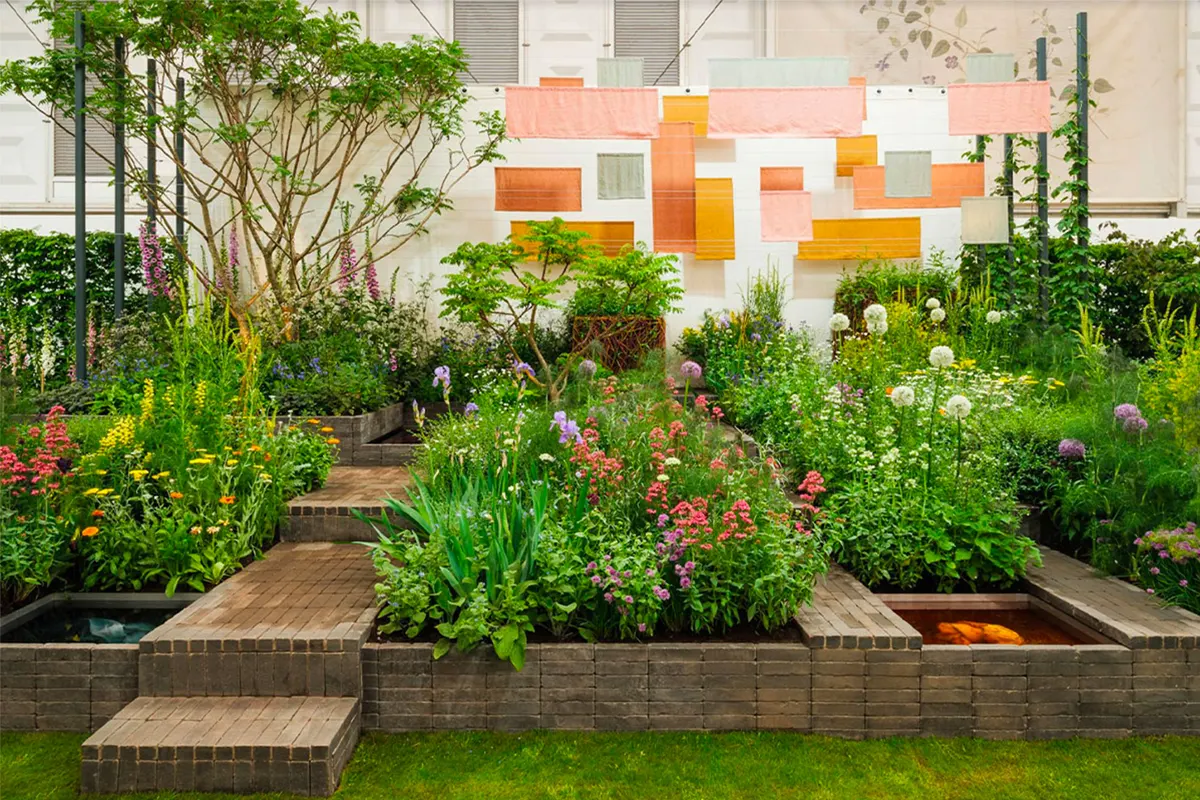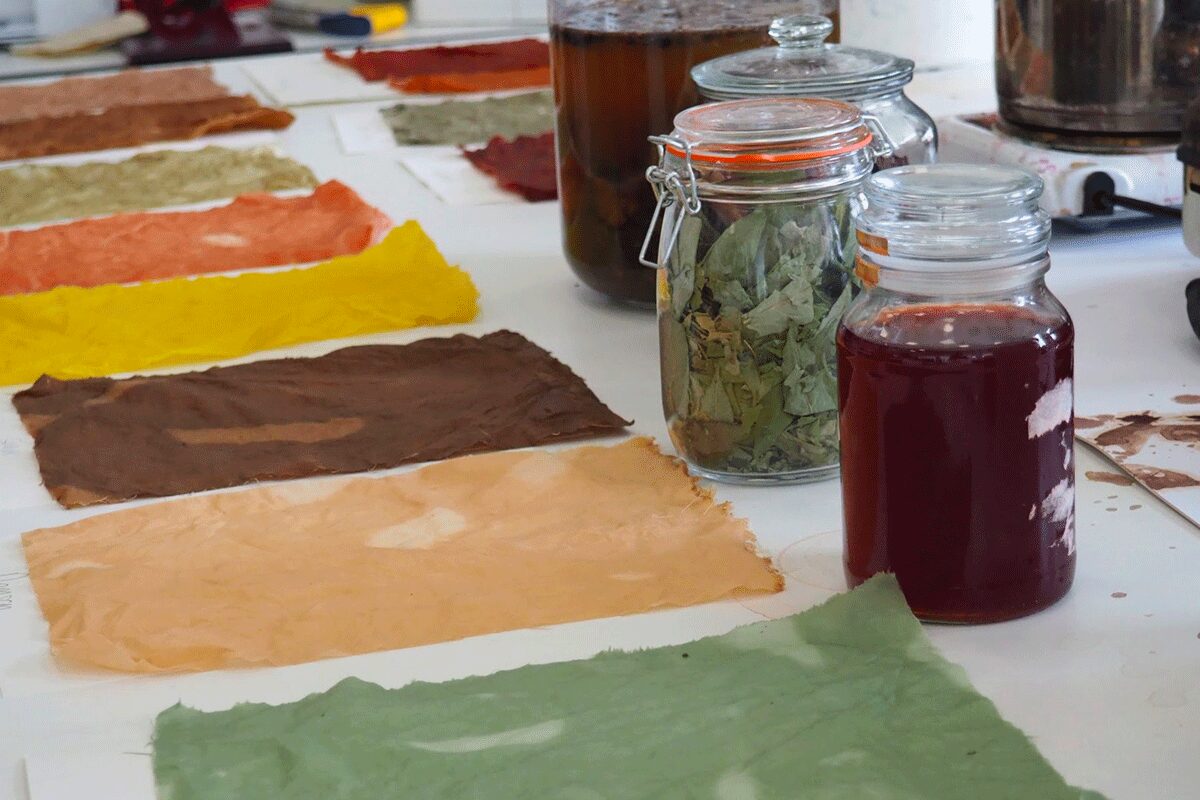Through a living installation, ‘A Textile Garden’ serves food for thought: what is the relationship between what we grow and what we wear?
Through a living installation, ‘A Textile Garden’ serves food for thought: what is the relationship between what we grow and what we wear?
Serving as a precursor to the futuristic concept of hyper-local and home-grown garments, is the living installation, A Textile Garden. The collaborative project by not-for-profit group, Fashion Revolution, questions the relationship between what we grow and what we wear. Amidst rising consciousness about plant-based fashion, this show is a comment on the role of plants as natural dyeing agents and raw fibers for textiles. With the fashion industry being held accountable as one of the largest contributors to the climate crisis, Fashion Revolution believes that this garden sows a seed of curiosity, for consumers to ask what’s in clothes?
Behind the scenery: Lottie Delamain
Lottie Delamain, designer for A Textile Garden, shares that the inspiration for the project dates back to a trek in Northern Vietnam; where she met the H’mong people who grew plants like indigo and hemp for clothes-making alongside the vegetables they used for daily sustenance: «I was so struck by the proximity they had to their clothes, the intimate understanding they had of where their clothes came from and how they were produced – a far cry from our current relationship with fashion in the modern west».
From fabric to dye, the current fashion industry is privileged with a vast choice of materials and ingredients that can be directly shipped to doorsteps. Delamain believes that this has led people to be wholly divorced from the skills and methods required to grow or produce such materials. Re-bridging that lost connection became the founding principle for the garden. «I wanted to challenge myself to create something using the resources we have readily available, using a restricted palette that would force a new creative approach, that explored the lost connection between plants and textiles» shared the garden designer.
Annie Albers – Blurring lines between traditional crafts and contemporary art
To visualize this holistic message, Delamain looked to German textile artist and printmaker, Annie Albers. Known for blurring lines between traditional crafts and contemporary art, her modernist principles and aesthetic formed the base of Delamain’s vision. «I started by creating a simple weave using paper following a pattern from one of Anni Albers’ books. This became the start of the geometry for my garden. I added a large-scale textile installation using linen woven from UK-grown flax, dyed using plant-based dyes».
Curating a textile garden
‘A Textile Garden,’ featuring plants solely used to dye or make clothes, is made in imitation of a woven textile. The chosen verdure of weeds, herbs and shrubbery is planted in distinctive color blocks to visually create the impression of a weave. It also features shallow pools functioning as dye baths where naturally made textiles are soaking in natural pigments, while a paved pathway through the garden is representative of seams.
Bringing this garden to life took more than a green thumb: intensive research to learn about dyeing processes, combing archives to find historically used stains and speaking with natural dye enthusiasts was part of the process. Delamain worked with Kelways, a UK-based nursery that grew 1500 plants for the garden including flax (used to make linen), nettle, woad (for blue dye), weld, fennel and cow parsley (for yellow dye) along with sumac and madder for orange and red hues. The challenge in arranging the assortment is that many of these plants are wild in nature, and difficult to maintain as ornamentals. Delamain shares, «Nettle is a great fiber plant, but hard to place in a garden. Likewise, weld is a weedy plant that is often seen in hedgerows around the UK».
Textile garden, the exhibition
The garden is intentional in its holistic design; showing both the growing phase of the plants, as well as their end-use. A textile installation forms the backdrop of the exhibit, evoking the sense of being within a loom, seeing warp and weft. Upcycled linen fabrics are suspended using a series of lateral wires and dyed with natural plants.
Initially exhibited at the RHS Chelsea Flower Show in late May, the garden was relocated to Headington School in Oxford under the guidance of Kate Turnbull, Head of Fashion and Textiles Design. She has developed a new syllabus focused on the study of plants for textile dyeing and manufacturing.
Putting DIY in dyeing: Kate Turnbull
Delamain lauds Turbull as a hugely knowledgeable natural dye practitioner, and the primary contributor to the textile installation in the garden. Turnbull and her students foraged linen panels and dyed them using different parts of plants; an effort to demonstrate their versatility in color extraction. The fabrics used were stained in yellow, using daffodil and dandelion heads, in rust using rhubarb roots, and in pink using cherry bark and madder roots. Nettle leaves which are ideal for fiber, were gently simmered with a copper modifier to create the green dye. Turnbull maintained the grid-like formation, essential in reflecting Annie Alber’s influence on the garden’s structural approach.
The re-imagined textile garden at Headington School will be executed in two parts: as a working dye garden for students to source from and an inspirational color wheel. It was the growing awareness about toxic levels of the textile industry that directed Turnbull towards a revamp in curriculum and practices: «It began with simple changes, such as embargoing aerosols, acrylic paints and synthetic materials and then through lockdown we were able to focus on how to re-engineer the course and maximize the potential for a comprehensive Eco-Textiles education. We began extracting and dyeing with color from plants and making inks from berries and foraged botanicals». Her students now make their own dye, ink, glue, print pastes and also upcycle old sheets to practice garment construction and dyeing.
Call to Action: dye your own clothes
Such practices of natural dyeing were in live-demonstration at the garden, through dye baths. Turnbull and Delamain were keen to show visitors the possibilities and potential of their own gardens: natural dyeing is simple and can easily be performed at home, as compared to the process of turning plants into fibers. Visitors were handed leaflets, sharing easy dyeing recipes and the different natively available plants that can be used to dye at home.
This educational hand-out was created in partnership with Bella Gonshorovitz, author of the recently published, slow-living book: Grow, Cook, Dye, Wear – From Seed to Style the Sustainable Way.
Garden to garment: Bella Gonshorovitz
A practitioner of the ‘garden to garment’ philosophy, Gonshorovitz starts from sowing seeds in her garden, to harvesting the produce for food, using the waste to create natural dyes and then dyeing and creating her own garments by upcycling home fabrics. «People don’t make the connection anymore between what they wear and nature. We’ve gotten used to consuming clothes in a very compressed way». To that end, her collaboration with Fashion Revolution for ‘A Textile Garden’ was focused on informing viewers about the accessibility of dyeing at home with relatively simple resources. She shared, «Fashion Revolution thought it would be great if I could give some dye recipes and explain how I dye with nettle, which is something that grows in either rural or urban areas and is incredibly invasive in the UK».
Gonshorovitz confirms that seeing dyeing baths at the textile garden was visually challenging for viewers, who usually visit for scenic flower displays. However, this year saw a big push for rewilding and sustainability, as a theme at the Chelsea Flower Show. «It had a philosophical underpinning – why the gardens were made, how you can represent environment friendly practices in your garden. The Textile Garden also imposed a key question on viewers – what’s in my clothes?»
Busting a myth: natural dyes can save the day
Over the years, the environmental cost of dyeing has been under debate repeatedly. Fashion Revolution reports that more than 15,000 chemicals can be used in the textile manufacturing process, most intensively in the dyeing and finishing phases. However, according to the Fashion Transparency Index 2021, less than thirty percent of brands share their commitments to eliminate such chemicals from garments. The chemicals leached in the waste water pollute natural waterways and are carcinogenic; becoming extremely harmful to humans under certain conditions.
In this regard, natural dyes are strong opponents. However their scope as an industrial scale solution remains questionable. Dyeing (be it using natural or synthetic agents) can require as much as 200 tonnes of water for every tonne of fabric. Further, natural dyes may be pollutant-free, but they require fixative chemicals for longevity and color fastening.
Large-scale cultivation of natural dyes
They only adhere to natural fibers, limiting their usage. They require dedicated land for cultivation. Moreover, large-scale cultivation of natural dyes is laced with a history of exploitation. Case in point: indigo slavery. Undoubtedly, the roster of issues associated with natural dyeing is lengthy and multi-faceted with few solutions at hand: regenerative farming, traceability across the supply chain and labor legislature, to name a few.
Long-term implementation can be catalyzed through immediate awareness and environmental contributions can be made by the masses. In this regard, ‘A Textile Garden’ plays a huge role. Turnbull is of a similar belief: «I hope that the symbolism and message of Lottie’s garden cuts through to the stakeholders and change-makers in the industry».
Bella Gonshorovitz
Dressmaker and writer, Bella Gonshorovitz recently published a slow-living book titled: Grow, Cook, Dye, Wear: From Seed to Style the Sustainable Way. She practices slow-fashion and creates her own naturally dyed home-grown garments by upcycling fabrics.
Fashion Revolution Partners
For ‘A Textile Garden,’ Fashion Revolution partnered with Lottie Delamain, who worked in textile design for fashion and homeware in South East Asia. She then retrained in garden design in the UK and has since been featured in multiple international publications. Kate Turnbull, head of fashion and textiles at Headington School in Oxford, was another collaborative partner in the project. She devised an Exo-Textiles curriculum for the school and has implemented natural dyeing practices from seed to dye, within the university program.




















